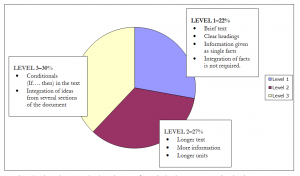It’s not easy to write clearly. This is why we often see confounding user guides, baffling instructions, and confusing handouts. But if it’s hard, why bother to write clearly?
A lack of literacy and essential skills
The International Adult Literacy and Skills Survey (IALSS ) in 2003 concluded that, “4 in 10 adult Canadians do not have the literacy skills they need to meet the ever-increasing demands of modern life”[1. International Adult Literacy and Skills Survey (IALSS, 2003].
The Nine Essential Skills (as identified by Human Resources and Skills Development Canada [2. Human Resources and Skills Development Canada, Literacy and Essential Skills, http://www.hrsdc.gc.ca/eng/workplaceskills/LES/index.shtml, accessed January 31, 2013.]) are:
- Reading text
- Document use
- Numeracy
- Writing
- Oral communication
- Working with others
- Continuous learning
- Thinking skills
- Computer use
The IALSS also identified reading levels and characteristics. This graph shows the percentage of Canadian adults reading at Levels 1, 2, and 3 [3. Literacy in Action, “Clear Writing and Design”, page 7, http://www.nald.ca/library/learning/cwd/cwd.pdf., accessed December 4, 2012.].
It’s clear that in order to reach most people, it’s important to write clearly.
A constant movement towards clear (or plain) writing
Since the beginning of the written word, people have tried to write clearly.

Statistics Canada studied literacy rates in 1990 and determined that 38% of Canadians between 16 and 69 years of age had difficulty with written material. [5. Statistics Canada, “Overview of literacy skills in Canada”, http://www.statcan.gc.ca/studies-etudes/75-001/archive/e-pdf/75-eng.pdf, accessed December 4, 2012.] Canada participated in the International Adult Literacy Survey in 1995 and 2003. [6. Statistics Canada, “International Adult Literacy and Skills Survey”, International Adult Literacy Survey (IAIB), accessed December 4, 2012.] These studies led to projects such as the Canadian Literacy and Learning Network, funded by the government’s Office of Literacy and Essential Skills [7. Canadian Literacy and Learning Network, “About Us” page, http://www.literacy.ca/, accessed December 4, 2012.] and the Language Portal of Canada’s Tools for Writers [8. Government of Canada, Language Portal of Canada, “Tools for Writers”, http://www.noslangues-ourlanguages.gc.ca/decouvrir-discover/outils-tools/oar-wt-eng.html, accessed December 4, 2012.].
The U.K. Plain English Campaign officially began in 1979 after the founder, Chrissie Maher, shredded hundreds of gobbledygook-filled official documents in Parliament Square, London, England. The Campaign presents a Foot in Mouth Award each year for “a baffling comment by a public figure.” [4. Plain English Campaign, http://www.plainenglish.co.uk/about-us.html, accessed December 4, 2012.]
The U.S. government introduced the Plain Writing Act in 2009 and President Obama signed it into law in 2010. The legislation is intended, “To enhance citizen access to Government information and services by establishing that Government documents issued to the public must be written clearly, and for other purposes.” [9. Public Law 111-274, http://www.gpo.gov/fdsys/pkg/PLAW-111publ274/pdf/PLAW-111publ274.pdf, accessed December 4, 2012.]
So what IS clear writing?

“ ‘Clear Writing’ is a way of presenting information so that it is easy for everyone to read and understand. Clear Writing considers how the material looks, as well as what it says.” [10. Ontario Ministry of Agriculture, Food and Rural Affairs, Clear Writing Factsheet, http://www.omafra.gov.on.ca/english/rural/facts/07-049.htm, accessed Dec. 3, 2012]
Consider the following when writing:
Clear writing:
- Focus on readers’ needs (consider an appropriate reading level, terminology, word use, structure)
- Use correct and consistent spelling and grammar (consider spelling standards for different audiences)
- Simplify (consider simple instead of complex words, speak to the reader actively)
Clear design:
- Apply consistent branding (consider logo, colour, templates)
- Use colour carefully for readability (consider contrast, colour vision deficiency)
- Choose appropriate images (consider usage, message, copyright law)
Clear layout:
- Include white space (consider spacing, margins, amount of material)
- Reduce visual distraction (consider importance of content, remove extra)
- Organize and streamline content (consider flow, structure, pacing)
Simply taking the time to write, read, and then re-write is important. Try reading out loud. It helps clarify what needs editing.
Let the message be clear!

